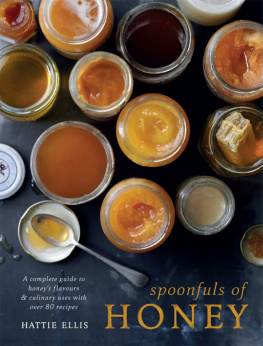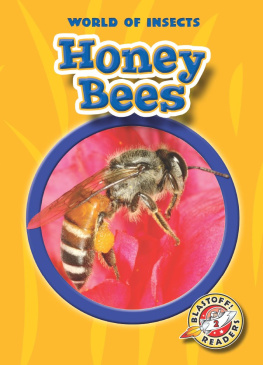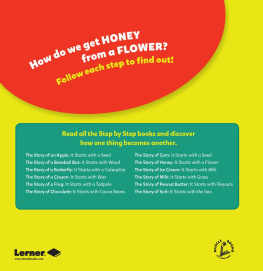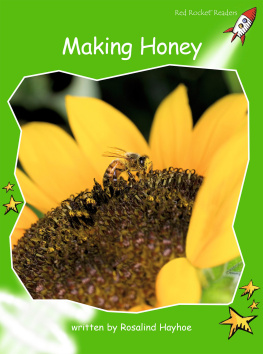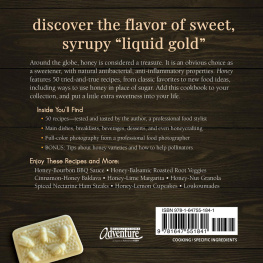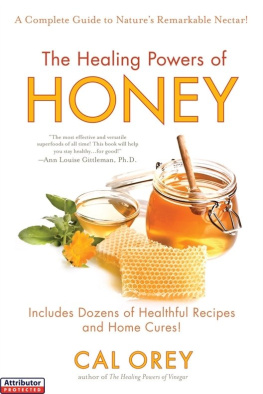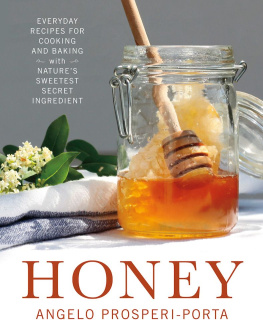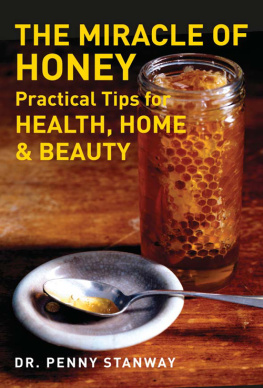


For Willie, Daphne, Stephen, Heather and Frances, and the next William, with love and thanks for all you do at Chain Bridge Honey Farm

Hattie Ellis

CONTENTS


WHAT IS HONEY?
Honey has the sweetest associations. Put a dab on your tongue and let its smooth sugars dissolve into a long hit of flavour and energy. It makes you think of summer days when bees buzz between flowers in the sunshine.
This benevolence spreads into the kitchen. A teaspoon of honey sweetens and deepens a tisane or stew and adds lustre to a sauce. Sweet tarts, cakes and roasts are burnished by its glow. Syrup-drenched baklava, glazed chicken wings and sticky ribs are made special with a touch of honey. Glistening threads are drizzled over crisp fritters or slices of Italian cheese such as pecorino. A spoonful of honey keeps breads soft and fresh; cakes and gingerbreads made with spices and honey improve as the moist crumbs soften and the flavours meld over time. You dont need much honey in a dish, but it always makes a difference.
There are many varieties of honey to explore. Its colours range from palest gold to deep mahogany, its flavours from gentle sweetness to a fragrant bitterness. Honey comes from wild flowers, woodlands, urban gardens and rainforests. It gives you a sense of place, be it a London park, Scottish moor, Tuscan woodland, Alpine meadow, Australian forest or Californian mountainside.
For all this variety, we should start at the beginning. What is honey?
Honey is concentrated nectar, pure and simple. Nectar is a sugary liquid, around 7080 per cent water, which is collected from plants by the bees and carried back to the hive in a small internal sac known as a honey tummy. Back in the dark interior of the hive, the nectar is reduced right down as thousands of honeybees pass droplets from one to the other and fan their wings to evaporate the water. It reduces down to a sticky substance that is around 18 per cent water and is stored in the little hexagonal wax cells of the honeycomb, as if in small pots. The bees cover each cell with a wax cap.
What is this honey for? It is food for the bees, their carbohydrate source to give them energy to fly and collect more nectar and make more honey. They collect this sticky liquid energy in the long warm days when nectar flows and store it in combs to use when needed.
The honey in our pots has been extracted from honeycomb by beekeepers and stored so that we, too, have sustenance on hand. It was mankinds first and most potent form of sweetness, predating the widespread use of sugar by many millennia. Long before hives were invented, honey hunters sought out caches of sweet comb in the wild.
From prehistory onwards, mankinds love of bees, honey and all that they symbolize has been part of music, poetry, architecture, art, philosophy, politics and religion. We yearned for a Biblical land of milk and honey; we see the hives community as a metaphor for human society and we design buildings like honeycomb; we sing of the bees buzz. People all over the world have used honey for ceremony and celebration. Fermented honey, or mead, was one of the first means of intoxication, long before grapes were pressed to make wine. Wax from the comb provided an early form of light, the sweetly scented candles that lit churches and wealthy homes. Throughout human history honey has seemed so beautiful and good as to be almost miraculous, and honeybees were seen as mysterious creatures of supernatural power.

Honey is just as significant, in these days of urban life and environmental uncertainty, through its closeness to nature. Appreciating this gives the honey-lover a more intimate and knowledgeable connection with the natural world around us, to be found even in green corners of the inner city.
Inspiration for the recipes in this book comes from a sense of the natural history of food, seen at close quarters. Most days in the spring, summer and early autumn you can go outside and watch bees land on blooms, bury their heads in the centre as they seek out the nectar, and come away laden, their bodies dusty with pollen. Then you can go back to the kitchen, put a spoon in a pot and taste this connection.
A number of the recipes come from the many countries Ive visited to learn about food and talk to beekeepers, from New Zealand to New York City. Many of the recipes use just a small amount of honey. Bees gather nectar from some two million flowers to make a single 450g/1lb jar of honey. Honey is powerful and precious. This book will show how to use it to best advantage and enjoy it most; an appreciation of honey, bees and the sweet goodness of one of the most extraordinary foods in the world.

AZ OF HONEY
When peering into the golden depths of a pot of honey at home, choosing what to buy, or talking to honey producers, a little knowledge can be a useful thing.
BLENDED HONEY
The most widely available commercial honey is blended from various sources by honey packers in order to get a consistent product for different retailers. This sort of honey is less expensive than pots produced by beekeepers from their own hives, which contain honey made from the nectar of flowers of a particular time and place.
COLOUR
Honeys vary in colour from very pale gold the lightest category in the United States is called water-white to dark brown-black. The colour (and flavour) of the honey depends on the nectar of the plants the bees visit. There is the pale, greeny gold of apple blossom honey, the exquisite light gold of acacia honey, the foxy red of heather honey, the amber of manuka honey and the near-black of some forest honeys. Darker honeys contain more minerals and are generally slightly more nutritious and stronger-tasting than lighter ones.
CRYSTALLIZATION
The texture of honey depends partly upon the composition of sugars in the nectar, and partly upon the age of the honey and how it is produced and stored. Some honeys crystallize quickly, while others remain runny for longer. Honeys with a high proportion of fructose, such as acacia, will stay liquid for much longer than those with more glucose, such as oilseed rape honey. See also Set, creamed or whipped honey.
FILTRATION
Next page
